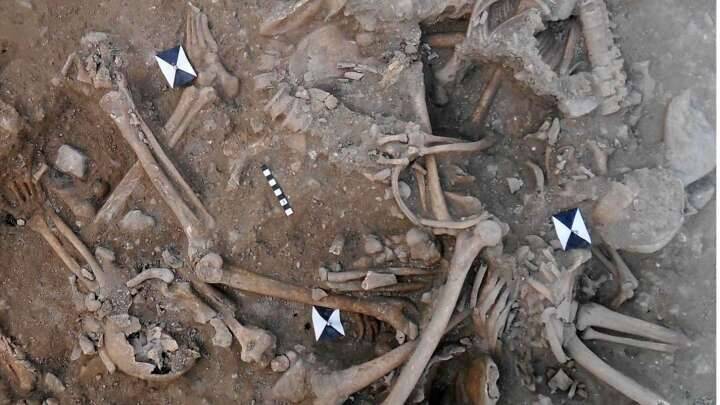The crusaders likely died sometime around the 13th century after losing control of the city of Sidon.
C. Doumet - Serhal / DGAThe grave accent contains at least 25 underframe , all male .
Between 1096 and 1291 , waves of Europeans took up arms and marched to the Middle East . They hoped to “ retake ” the Holy Land . But a great number of these Christian crusaders never came home , and a mass grave see in Lebanon offer gruesome proof of their tearing death .
archaeologist break the deal grave within the ironic moat of Sidon Castle . It hold back the corpse of at least 25 men and teenagers , whose chip and scorch bones give a hint about their violent ends .

C. Doumet-Serhal/DGAThe grave contains at least 25 skeletons, all male.
“ When we discover so many weapon injuries on the bones as we excavate them , I knew we had made a particular discovery,”said Dr. Richard Mikulski , an archaeologist with Bournemouth University who excavated and analyse the clay .
Dr. Piers Mitchell , of the University of Cambridge , a reformer expert on the project , tally .
“ So many thousands of people died on all sides during the Crusades , ” he noted , “ but it is fantastically uncommon for archaeologist to discover the soldiers killed in these renowned fight .

Mikulski et al.A diagram shows the extensive injuries suffered by one Crusader.
“ The wound that covered their eubstance let us to come out to understand the horrific reality of medieval warfare . ”
Indeed , the remains showed a “ gamy prevalence of unhealed sharp force , riddle force , and blunt personnel trauma consistent with medieval weapons system , ” accordingto the diary PLoS ONE . archeologist also find a crusader coin and a “ Frankish belt buckle ” among other small artifact .
FurtherDNA and isotope analysis confirmedwhat the archeologists had suspect — the skeletons were European military personnel who had fought , and die , during the Crusades .
Mikulski et al . A diagram shows the all-inclusive injury suffered by one Crusader .
Archeologists conceive that the human died sometime around the thirteenth century . Though Christian crusaders had come after in taking the Lebanese metropolis of Sidon in 1110 , they give out to hold it . Mamluk soldiery attacked and destroy the metropolis in 1253 and Mongol troops ravaged the relief in 1260 .
During one of these two battles , assail violence veil the Crusaders .
“ All the bodies were of teenage or adult males , indicating that they were combatants who fought in the battle when Sidon was round , ” explain Mikulski . Their ages likely ranged from 15 to 66 .
Though hundreds of years have passed , the Crusaders ’ skeleton offer grisly hints about how they died . Some have injuries to the backs of their dead body , suggesting they were killed as they flee . Others have steel wounds on the back of their cervix , indicating that they were captured live and executed by decapitation .
“ The bulk of the sharp force lesions are indicative of heavy bladed weapon system such as swords and axes , ” observe the clause in PLoS ONE . It went on to say that some injuries seem “ compatible with a blow from a spiked macebearer . ”
But once the battle terminate , and the dust settled , the Crusader ’s body were get out to rot . They remained in the blistering sun , unburied , perhaps for some metre . Eventually , record suggest that fellow Crusaders arrive across the urban center and buried the men .
“ The means the body parts were position suggest they had been leave to decompose on the surface before being dropped into a stone , ” explain Dr. Mark Smith , also of Bournemouth University . “ char on some clappers propose they used fire to cauterize some of the bodies . ”
Certainly , the breakthrough of the raft grave is significant because of its rarity . Archeologists are promising to use the remains of the Crusaders to learn more about living ( and death ) in the Middle Ages .
But this tomb is renowned for another reasonableness as well . Mitchell mention that King Louis IX of France was on a crusade himself when the urban center of Sidon drop in the 13th century .
“ He blend in to the city after the struggle and personally helped to bury the rotting clay in mass graves such as these , ” Mitchell explained . “ Would n’t it be amazing if King Louis himself had helped to bury these consistency ? ”
After reading about the mess grave accent of Christian crusaders , discover about themass grave accent of Nazi paratroopersfound in Poland . Or , discover the strange and pitiful story of themass tomb of mummified penguinsin Antarctica .